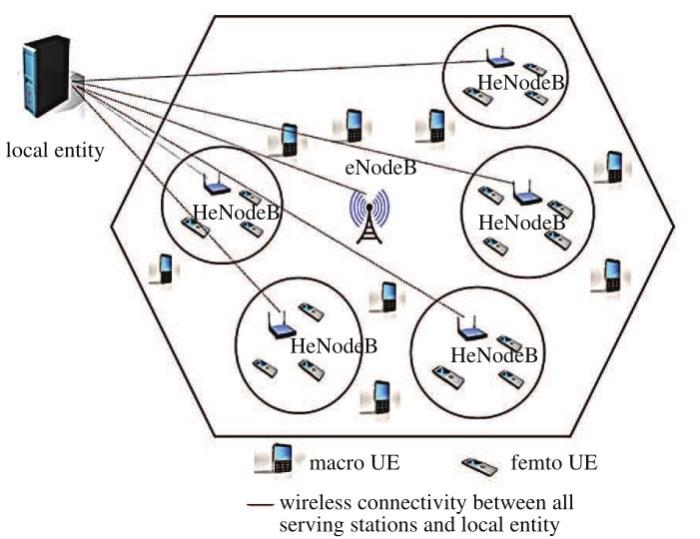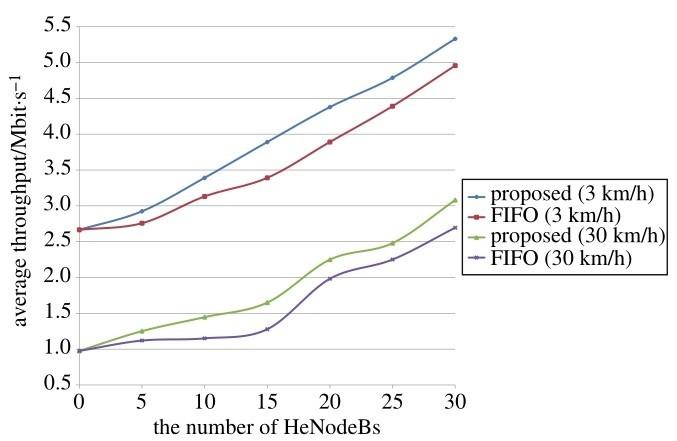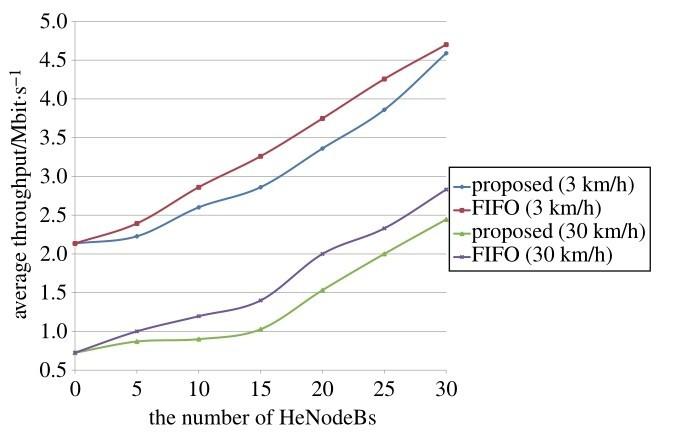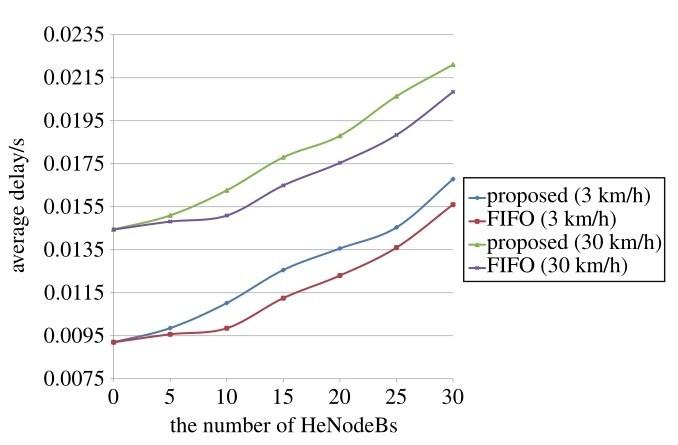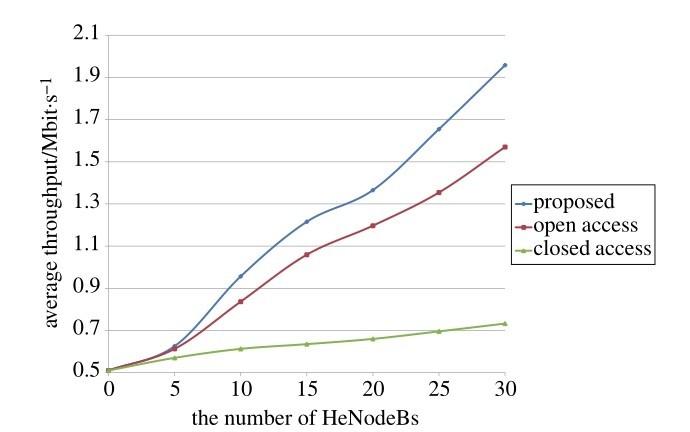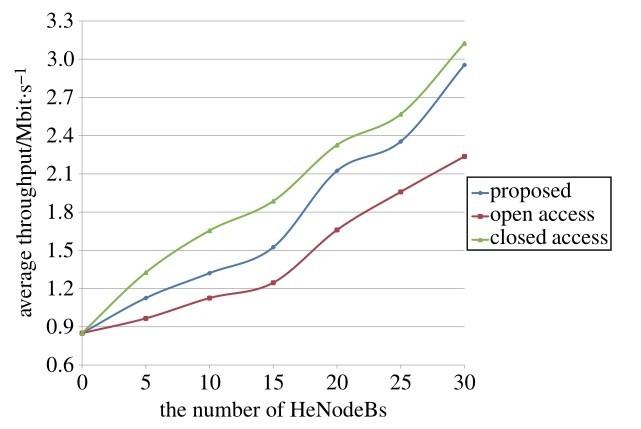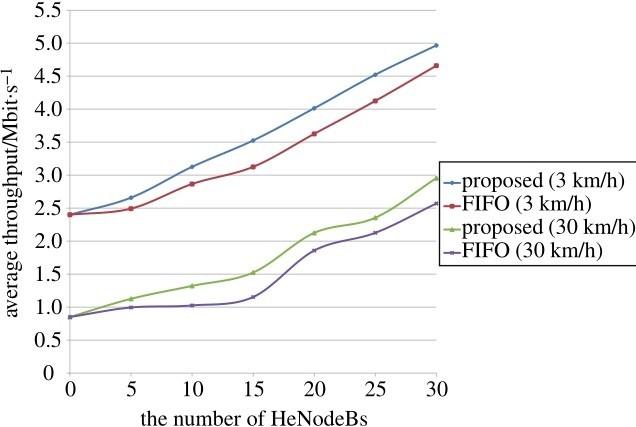Ⅰ. INTRODUCTION
Femtocells are considered as a favorable solution for theemerging high-bandwidth requirements of multimedia applications[1,2]. Together with advanced technologies such as long-term evolution(LTE), it is expected that there will be an increase in the overall network capacity. Femtocells are small, low-power base stations that can be overlaid on existing cellular networks[3]. To this end, the 3rd Generation Partner ship Project (3GPP) has initiated the deployment of heterogeneous networks in LTE-Advanced specifications. Heterogeneous networks consist of macrocells and low-power nodes such as microcells, picocells, and femtocells[4]. Femtocells are mainly developed to provide broadband connectivity in indoor environments. The traffic generated from indoor environments suffers from poor signal quality and higher penetration losses, which leads to a requirement for more resources to guarantee the required quality of service(QoS). Femtocells have therefore been introduced to overcome the indoor coverage problem and enhance the cell capacity by offloading the traffic from macrocell Evolved Node Bs(eNodeBs). From an operator’s point of view, this traffic offloading will lead to the need for fewer macrocell sites, which results in huge Capital Expenditure(CAPEX)savings and uninterrupted user experience in both indoor and outdoor environments[5].
Femtocells operate in the licensed frequency bands, and can be easily installed by consumers upon enabling smallcoverage radio-based stations, also called Home eNodeBs (HeNodeBs). However, the extensive installation of femtocells can cause severe interference-related issues[6]. Because macrocells and femtocells use shared spectrum, strong crosstier interference can exist between both the tiers. The severity of the cross-tier interference depends significantly on the access mechanism used in the femtocell network[7]. In access control mechanisms, users can be classified as subscribers who are registered users or nonsubscribers who are random mobile users, depending on the connectivity privileges.
Three access methods have been proposed for femtocells in the 3GPP specifications: closed access, open access, and hybrid access, as shown in Fig.1.
In closed-access mode, only subscribers are granted access to the corresponding femtocells. Although this access method increases the QoS of registered user equipment (UE), it will result in severe interference-related issues. Many studies have been performed to achieve interference mitigation, including power control[8,9,10,11] , spectrumsharing techniques[12,13,14], and cognitive approaches[15,16]. In Ref. [17], the resource-allocation problem in a two-tier orthogonal frequency-division multiple access(OFDMA)based network is studied, where the femtocells employ closedaccess mode and have cognitive radio capability to sense the channel environment. The cognitive radio capability helps the femtocells to choose the subchannels that have minimal interference and that maximize the sum throughput of femtocell users. In an open-access mode, all the users are permitted to connect via the femtocells. Earlier studies[18,19] have shown that the installation of open-access femtocells improves the system performance by offloading the macrocell traffic. In Ref. [20], a resource-allocation method for openaccess OFDMA femtocells is proposed by using cognitiveradio technology in femtocells. This access mode is used as an alternative approach for interference reduction because UEs will try to connect to the server with the strongest signal. However, this access mode will lead to an increase in the number of handovers, negatively impacting operators.
Figure 1
Figure 1
Access control mechanisms in LTE femtocell
As a compromise between these two access methods, the hybrid access method is introduced, allowing preferential access for subscribers and limited access for nonsubscribers[21]. The resource sharing between subscribers and nonsubscribers in a femtocell network needs to be regulated as it is necessary to guarantee the minimum throughput required by subscribers. The remaining resources can then be allocated among nonsubscribers in an efficient way by effectively using different scheduling methods. Nonsubscribers can be served on a first-come first-serve basis, or priority can be given based on their service requirements[22]. This study investigates resource scheduling for femtocell networks in hybrid-access mode, which gives preferential access to high-priority traffic, thereby increasing the overall average throughput of highpriority users in a network.
The rest of the paper is organized as follows. The system model of hybrid-access femtocell networks is described in section Ⅱ. In section Ⅲ, the proposed resource-scheduling method is explained in detail. In section Ⅳ, the simulation results are discussed. The conclusions are presented in section V.
Ⅱ. SYSTEM DESCRIPTION
In this paper, a downlink(DL)OFDMA-based scenario is considered that consists of a single macrocell and between 130 femtocells. The macrocell eNodeB is located at the center, while the femtocells f ∈{1, 2, …, F}are randomly distributed within the coverage area of the macrocell. It is assumed that the total power is equally divided among all the subcarriers. It is also assumed that none of the femtocells overlap with one another or with the macrocell eNodeB. The cochannel deployment is considered in the system, which indicates that both the macrocell and femtocells use shared spectrum. The macrocell eNodeB and all femtocell HeNodeBs are linked to a local entity that controls the resource management centrally in the system, as shown in Fig.2. The local entity obtains the overall channel-state information at the beginning of every transmit time interval(TTI)to determine which base station has to provide service to the UE. This information is reported from base stations to a local entity using a feedback method. It is assumed that all the femtocells f ∈{1, 2, …, F}in the macrocell coverage area operate in the hybrid-access mode, with every femtocell serving k∈{1, 2, …, K} users. In OFDMA-based LTE networks, the available bandwidth is divided into the number of resource blocks (RBs) based on the time and frequency domains[23]. An RB is the smallest schedulable unit that can be modulated independently in an LTE network. An RB consists of 12 continuous subcarriers in the frequency domain, and has a 0.5 ms duration in the time domain. The allocation period is called one TTI, and it lasts for 1 ms duration. Therefore, the femtocell has the advantage of scheduling resources orthogonally to the UEs, thereby minimizing performance degradation due to interference.
Figure 2
Figure 2
System model considered
In the system considered with a hybrid-access mode, if the UE has a high signal-to-interference-plus-noise ratio(SINR)from the nearest femtocell than from the originally associated macrocell, then the macrocell eNodeB can offload the UE to the femtocell, thereby increasing the overall cell capacity. However, the subscribers of femtocells are given priority for resource allocation when they are present in the coverage area of their registered femtocells. Nonsubscribers will be in connection with the macrocell eNodeB. When they are near the vicinity of the femtocell network, the connectivity of nonsubscribers should be assessed to determine whether they need to switch over to the femtocell network or if they remain connected with the macrocell eNodeB. This decision can be made by analyzing the link conditions between them and the base stations. However, they can be connected to the femtocell based on their service requirement and femtocell resource availability.
Ⅲ. PROPOSED RESOURCE-SCHEDULING METHOD
Nowadays, multimedia services such as voice over Internet protocol(VoIP)and video are becoming very important applications in telecommunication technology. These high-priority traffic technologies have strict delay and packet-loss requirements. When a user with these types of services is moving away from an eNodeB, the quality of experience of that particular user decreases. Femtocells are introduced mainly to improve the signal quality and to increase the overall cell capacity. Closed-access femtocells provide service only to registered subscribers, even though they have resources at a particular instant in time. These types of femtocells are generally preferred in home environments. However, open-access femtocells can serve all users based on their resource availability, but they are not preferred in home environments. Hybridaccess femtocells also share some limited resources with nonsubscribers. If femtocells serve users based on the traffic type, then the overall throughput of high-priority traffic can be improved. In the proposed method, the user who needs a handover from a macrocell to a femtocell is also included in the high-priority traffic. Because the proposed method uses hybrid access femtocells, the serving-station selection needs to be performed before resource allocation. The choice of serving station is made by the local entity, which performs functions such as link management as well as handover mechanisms between eNodeBs and HeNodeBs.
A. Serving-Station Selection
The serving station selection is performed by investigating the SINR of a particular user with respect to the macrocell eNodeB and femtocell HeNodeB. The SINR of a user at the nth RB with respect to the macrocell eNodeB is calculated as
where Pm, n is the transmission power from the macrocell eNodeB, Gm, n is the channel gain from the macrocell to the user, Pf, n is the transmission power of interfering femtocells, G f, n is the channel gain from the femtocell to the user, N0 is the noise spectral density, and w is the bandwidth of the RB. The SINR of a user at the nth RB with respect to the femtocell HeNodeB is calculated as
where Pk, n is the transmission power from the femtocell HeNodeB with k∈F, Gk, n is the channel gain from the femtocell to the user, Pi, n is the transmission power of interfering femtocells, and Gi, n is the channel gain from the interfering femtocells to the user. Initially, the user will calculate the SINR value for all the serving stations, including macrocell and femtocells, based on the channel quality it experiences. The serving station will adopt the corresponding modulation and coding scheme(MCS)for the user, as shown in Tab.1[24], for its calculated SINR value.
Table 1 MCS table in LTE DL
| CQI | modulation order | code rate×1024 | SINR threshold/dB |
| 0 | out of range | ||
| 1 | QPSK | 78 | −9.478 |
| 2 | QPSK | 120 | −6.658 |
| 3 | QPSK | 193 | −4.098 |
| 4 | QPSK | 308 | −1.798 |
| 5 | QPSK | 449 | 0.399 |
| 6 | QPSK | 602 | 2.424 |
| 7 | 16QAM | 378 | 4.489 |
| 8 | 16QAM | 490 | 6.367 |
| 9 | 16QAM | 616 | 8.456 |
| 10 | 64QAM | 466 | 10.266 |
| 11 | 64QAM | 567 | 12.218 |
| 12 | 64QAM | 666 | 14.122 |
| 13 | 64QAM | 772 | 15.849 |
| 14 | 64QAM | 873 | 17.786 |
| 15 | 64QAM | 948 | 19.809 |
After calculating the SINR values, the user will check if
where γM is the SINR from the macrocell eNodeB, γF is the SINR from femtocell HeNodeB, γth is the SINR threshold. This threshold value can be taken based on the operator’s requirement. For a simulation, 7 dB is taken as the threshold value. This is because with a threshold value above 7 dB, a user can switch from one modulation order to another that reduces the resource requirements for that user. If the user has an SINR difference that exceeds the threshold value, then it may request access to the femtocell. Eq. (3)is calculated only for nonsubscribers. The femtocell can grant access to the user based on the traffic type and resource availability. The steps involved at the local entity for connecting the UE with a femtocell or to make a handoff from a macrocell to a femtocell are shown in Algorithm 1.
Algorithm 1 At local entity
Calculate SINR of UE with respect to macrocell using Eq. (1)
Calculate SINR of UE with respect to femtocell using Eq. (2)
For every TTI do
if γM−γF> γth then
check the resource availability at femtocell
connect UE with femtocell or
else connect UE with macrocell
end if
end for
B. Resource Scheduling
In hybrid-access mode femtocells, separate scheduling methods can be used for subscribers and nonsubscribers. Mostly, the conventional method of scheduling, which is called first-in first-out(FIFO), is adopted for nonsubscribers because of its simplicity. However, by giving preferen-tial access to the high-priority traffic of nonsubscribers, the overall throughput of the high priority traffic in the net-work is increased. High-priority traffic includes real-time services and handoff traffic from the macrocell, and low-priority traffic includes non-real-time services. To sched-ule nonsubscribers in femtocells, the service-based scheduler (SBS)method is adopted[25]. The flowchart of the proposed resource-scheduling method in a hybrid-access femtocell is shown in Fig.3.
Initially, the resources are fixed for subscribers and nonsubscribers in the femtocell. If more resources are needed by the subscribers, then some resources are released from nonsubscribers’resource pool to guarantee the minimum rate requested by the subscribers in the femtocell. While performing resource allocation for nonsubscribers, preference is given to the high-priority services. For resource scheduling of the nonsubscribers, the SBS algorithm is used. The SBS algorithm estimates two values, namely THP and TLP, for nonsubscribers based on their type of service, and they put nonsubscribers in a separate list. These lists are arranged in ascending order using any sorting algorithm, and the allocation of nonsubscribers is done initially from the THP list and TLP then from the list. Based on the reported channel quality indicator(CQI)value obtained from the user, RBs are assigned. The values of THP and TLP for a particular packet is calculated as follows:
where Td is the theoretical departure time, which is the difference between the packet delay budget value and the head of line(HoL)delay value,
where ri(max) is the maximum bit rate of that service. Using this method, high-priority traffic obtains preferential access, and the overall throughput of the high-priority traffic is improved. The steps involved in the femtocell for providing resources to nonsubscribers are shown in Algorithm 2.
Algorithm 2 At femtocell
While the nonsubscribers join the network do
Calculate THP for high priority UEs using Eq. (4)
Calculate TLP for low priority UE using Eq. (5)
Sort THP and TLP list separately
For every TTI do
if current TTI has resources
after allocating subscribers then
select UEs from THP list
allocate resources
if current TTI has resources
after allocating UEs from THP list then
select UEs from TLP list
allocate resources
end if
end for
Ⅳ. SIMULATION RESULTS
A single-cell DL scenario is considered with femtocells (the number ranges from 1 to 30) distributed randomly inside the cell without overlapping each other. It is assumed that users move with speeds of 3 km/h and 30 km/h. For outdoor users, a 6-ray typical urban channel model is adopted, and for indoor users, the WINNER Ⅱ channel model is used. To minimize the complexity of the simulation, the reception of a perfect CQI report from the user is assumed. It is also assumed that at any instance of time, 60% of users will be in high-priority traffic and 40% of users will be in low-priority traffic. High-priority traffic includes VoIP, video, and handoff users, while low-priority traffic includes BE service users. Video flows with a source rate of 128 kbit/s are produced by a H. 264 trace-based coder, whereas VoIP flows with a source rate of 8 kbit/s are generated by a G. 729 audio coder. Finally, BE traffic is generated by an ideal source that always has packets to send. The main parameters used in the simulation are shown in Tab.2.
Figure 3
Figure 3
Proposed resource-scheduling method in hybrid-access femtocell
The performance of the proposed resource-allocation method is evaluated by increasing the number of femtocells in the given macrocell region using an open-source simulator, LTESim. The modules present in LTESim are explained in Ref. [26]. The average throughput of high-priority users at 3 km/h and 30 km/h is shown in Fig.4, from which it is observed that the average throughput of high-priority users increases with an increasing number of femtocells owing to the effective utilization of system resources. Because users are chosen from the THP list for resource allocation, high-priority users are allocated first, thereby increasing their overall average throughput. However, as the user’s speed increases, there is a high probability of packet loss, which leads to a decrease in the average throughput that can be seen in all the figures with two different user speeds.
From Fig.4, it is also observed that by using the pro posed resource-allocation method for nonsubscribers, there is considerable improvement in the average throughput of highpriority users when compared with the conventional method for nonsubscribers. When the femtocells use the conventional resource-scheduling method for nonsubscribers, users are allocated based on their entry time. Based on the proposed priority-based resource-allocation method, preferential access is given to high-priority users. Thereby, the overall average throughput of high-priority users is increased. Using the proposed resource-scheduling method, there is a 6. 8% improvement in the average throughput of nonsubscribers when compared to the conventional scheduling method with the parameters assumed for simulation at 3 km/h. At 30 km/h, there is a 14% improvement in the average throughput with the parameters taken for simulation. At the same time, the delay of the high-priority users is decreased, as shown in Fig.5, because of the preferential access to those users. There is a 5% and 4. 5% decrease in the average delay at 3 km/h and 30 km/h, respectively with the parameters assumed for simulation.
Table 2 Simulation parameters
| parameter | value |
| bandwidth | 10 MHz |
| carrier frequency | 2 GHz |
| subcarrier bandwidth | 15 kHz |
| the number of subcarriers | 600 |
| macrocell radius | 500 m |
| femtocell radius | 15 m |
| eNodeB transmission power | 43 dBm |
| HeNodeB transmission power | 17 dBm |
| the number of femtocells | 1∼30 |
| the maximum number of mobile users | 300 |
| the maximum number of subscribers/femtocell | 4 |
| subscriber’s minimum throughput | 4 Mbit/s |
| speed of macro user | 3 km/h and 30 km/h |
| speed of femto user | 0∼1 km/h |
| user application flow | 60% HP users and 40% LP users |
| channel model | 6-Ray Typical Urban(TU) |
| path loss | for outdoor,WINNER Ⅱ for indoor 128.1+37.6 logr(dB)for outdoor 37.78+36.8 logr(dB)for indoor |
| shadowing | log normal shadowing with 0 mean and 8 dB std.dev.in outdoor and 10 dB std.dev.in indoor |
| QPSK(1/2,2/3 and 3/4) | |
| modulation and coding | 16 QAM(1/2,2/3 and 3/4) |
| 64 QAM(2/3 and 3/4) | |
| external wall attenuation | 20 dB |
| simulation duration | 100 s |
Figure 4
Figure 4
Average throughput of high-priority users
Figure 5
Figure 5
Average delay of high-priority users
At the same time, a compromise should be made in the average throughput and delay of low-priority users, as shown in Fig.6 and Fig.7. There is a 7. 3% decrease in the average throughput and a 7% increase in the average delay at 3 km/h, and a 12% decrease in the average throughput and a 6. 1% increase in the average delay at 30 km/h for low-priority users with the parameters assumed for simulation. The increase in the delay with an increase in the number of femtocells shows the impact of interference in the network.
The average throughput of nonsubscribers when compared with other access modes is shown in Figs. 8 and 9. In general, the performance of nonsubscribers is higher in the hybridaccess mode, which is confirmed from the figures. The reason is that primarily, the cell-edge users who suffer from poor signal quality will try to access the femtocell network. With the hybrid-access method, these users are effectively served, increasing the average throughput of nonsubscribers. However, open-access femtocells allow all the users that are within its coverage area, increasing the number of handovers. Therefore, the average throughput of the open-access method is less than that of the hybrid-access method. For the same environment, the closed-access method gives access only to subscribers, and nonsubscribers therefore need to be connected only to the macrocell even though they have to communicate with poor signal quality. Thus, the average throughput of nonsubscribers in the closed-access mode is significantly less when compared with other access methods.
Figure 6
Figure 6
Average throughput of low-priority users
Figure 7
Figure 7
Average delay of low-priority users
The performance of the average throughput of all users with different access methods is shown in Figs. 10 and 11. In general, the performance of the closed-access method is superior in this case when compared to other access methods, which is confirmed by figures. This is because with the closedaccess method, the subscriber’s individual average throughput is maximized such that it improves the overall average throughput of all users in the network. However, in the hybridaccess mode, the subscribers’minimum throughput is guaranteed to serve a limited number of nonsubscribers, which improves the overall average throughput of all users. But it is less compared to the closed-access method. The open-access method shows poor throughput performance owing to an increase in signaling and the number of handovers.
When compared with the conventional scheduling method for nonsubscribers, the proposed method shows better performance in terms of the average throughput of all users. The conventional method treats all the nonsubscribers equally, such that it increases the delay experienced by high-priority services. When the number of femtocells increases, the impact of delays in the network also increases, reducing the overall throughput of users in the network, as shown in Fig.12. Using the proposed priority-based resourcescheduling method for nonsubscribers, there is an 8. 2% improvement in the average throughput of total users when compared to the conventional scheduling method at 3 km/h, as obtained with the parameters assumed for the simulation. At the same time, there is a 15% improvement in the average throughput at 30 km/h, as obtained with the parameters assumed for the simulation.
Figure 8
Figure 8
Average throughput of nonsubscribers when compared to other access methods at 3 km/h
Figure 9
Figure 9
Average throughput of nonsubscribers when compared to other access methods at 30 km/h
Ⅴ. CONCLUSION
This study investigates resource scheduling for femtocell networks in the hybrid-access mode, which gives preferential access to high-priority users in a network. Because the proposed method uses hybrid-access femtocells, the effective serving-station selection is performed before resource allocation. This serving-station selection is done by the local entity of the network based on the individual users’SINR feedback. After the serving-station selection, resource schedul ing is done by giving preferential access to the nonsubscribers that have high-priority traffic. It is performed by adopting the already-existing SBS algorithm. By estimating THP and TLP values and allocating the users, initially from the THP list and then from the TLP list, the overall throughput of the highpriority users is increased. Using the priority-based resourcescheduling method, there is a 6. 8% and 14% improvement in the average throughput of high-priority users at 3 km/h and 30 km/h, respectively, with the parameters assumed for the simulation. At the same time, the delay is reduced by 5% and 4. 5% at 3 km/h and 30 km/h, respectively.
Figure 10
Figure 10
Average throughput of all users when compared to other access methods at 3 km/h
Figure 11
Figure 11
Average throughput of all users when compared to other access methods at 30 km/h
Figure 12
Figure 12
Average throughput of all users
Reference
Femtocell networks: a survey
[J].
An overview of the femtocell concept
[J].
LTE femtocells: system design and performance analysis
[J].
A survey on 3GPP heterogeneous networks
[J].
On femto deployment architectures and macrocell offloading benefits in joint macro-femto deployments
[J].
Macro-femto heterogeneous network deployment and management: from business models to technical solutions
[J].
Open,closed and shared access femtocells in the downlink
[J].
QoS guaranteed power control mechanism based on the frame utilization for femtocells
[J].
Fast algorithms for joint power control and scheduling in wireless networks
[J].
Interference mitigation by dynamic self power control in femtocell scenarios in LTE network
[C]//
A self organized uplink power control for cross tier interference management in femtocell networks
[C]//
Dynamic orthogonal frequency division multiple access resource management for downlink interference avoidance in two tier networks
[J].
A hybrid frequency assignment for femtocells and coverage area analysis for co-channel operation
[J].
Spectrum allocation in two tier networks
[J].
Downlink interference minimization in cooperative cognitive LTE femtocell networks
[J].
Downlink spectrum sharing for cognitive radio femtocell networks
[J].
Resource allocation for femtocell networks by using chance constrained optimization
[C]//
Femtocell access control in the TDMA/OFDMA uplink
[C]//
Downlink femtocell networks: open or closed
[C]//
Resource allocation in open access OFDMA femtocell networks
[J].
Macrocell femtocells resource allocation with hybrid access motivational model
[J].
Access control mechanisms for femtocells
[J].
3GPP.Tech.Specific.Group Radio Access Network—Physical Channel and Modulation(Release 8)
[J].
MCS selection for throughput improvement in DL LTE system
[C]//
Performance analysis of service based scheduler in LTE OFDMA system
[J].
Simulating LTE cellular systems: an open source framework
[J].







